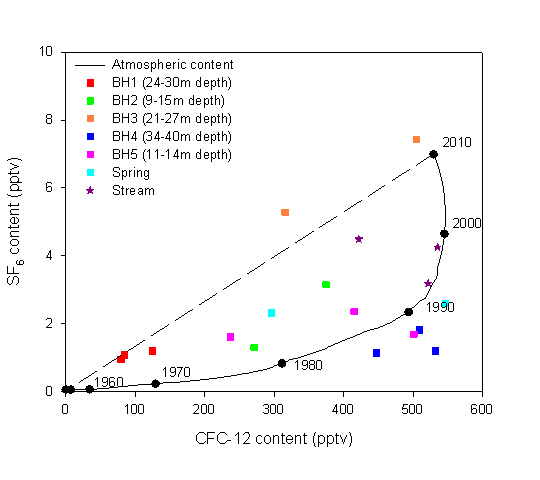When will NVZ nitrate mitigation measures be seen to have an effect on groundwaters?
Published on 6 January 2011 in Sustainability and Communities
Introduction
Under the requirements of the European Nitrates Directive (91/676/EEC), four areas of Scotland were designated as Nitrate Vulnerable Zones (NVZs) in 2002–03. These areas were identified as having groundwaters where nitrate levels exceed, or are likely to exceed, the level of 50mg/l nitrate set in the Directive. These NVZs cover some 14% of the land area of Scotland. An NVZ Action Programme (2008) sets out rules for farmers managing land that drains to water bodies within these NVZs. The objective of this Programme is to reduce the concentrations of nitrate leaching to groundwater from diffuse and point source agricultural pollution.
Most groundwater bodies in Scotland are relatively shallow and are considered to possess little potential for storing water in groundwater aquifers. However, this is not necessarily the case. For example, in the sandstone and breccia aquifer of the Lower Nithsdale NVZ, a study by MacDonald et al (2003) suggested that nitrate concentrations could still be expected to increase in the aquifer due to the proportion of pre-1950s water present. Since few other studies of groundwater residence time have been undertaken in Scotland, there is consequently little understanding about how long it might take for mitigation of current concentrations of nitrates in groundwater. This briefing outlines the findings of a recent study in the Strathmore and Fife NVZ, within the catchment of the Lunan Water. This was aimed at evaluating how rapidly groundwater can be expected to recover from past nitrate pollution.
Key Points
Groundwater bodies will not display instantaneous responses to changes in pollution because of the time delay in transmission of water and interaction of solutes carried by the water within the matrix of the bedrock. In some hydrogeological settings there is a deep unsaturated zone, through which water transmission is very slow. This is not generally the case for Scotland. However, the time-scales of water transmission are generally poorly quantified.
Research Undertaken
Measurements of CFCs and SF6 were made for 3 sets of water samples taken between Nov 2007 and Aug 2009 from five boreholes, one surface spring and two stream sites. The five boreholes were located at only three locations with two paired boreholes which were sampled at different depths. The depths of sampling ranged from 9–15 m to 34–40 m. Numerical models of groundwater transport processes were used to interpret the data and explore their implications for groundwater recovery. The measured data indicate a broad range of ages of the groundwater across this small number of samples as indicated in Figure 1. Broadly, data points that lie towards the lower left of the figure represent older waters, whilst those towards the upper right are more recent.
From one of the deeper boreholes (BH3), recent (last few years) water was sampled, presumably rapidly transported to depth by flow through fractures in the sandstone aquifer. At the other end of the scale, water from another borehole (BH1) indicated a proportion of around 80% ‘old’ (i.e. pre 1950s) water mixed with 20% recent water. The mean transit time for nitrate at this location would be greater than 100 years, assuming that the transport can be represented by a groundwater dispersion model. This model takes into account dispersion of the solute into the matrix of the rock. Other groundwater samples fell between these two extremes.

The implications of the results for groundwater recovery were also explored through numerical modelling. For locations where recent water was found, 70% of any reduction in leaching would be effective within 5 years. Where the mean transit time was estimated as 30 years, 70% of a reduction would be effective in 10 years, and for a mean transit time of 100 years 70% reduction would be effective in 18 years. In order to evaluate mean rates of recovery for the groundwater body as a whole, a greater number of samples would be required to capture the spatial heterogeneity.
Policy Implications
The Action Programme of Measures for NVZs is aimed at reducing concentrations of nitrate in groundwater. When assessing the effectiveness of programmes of measures, there are three key elements that must be considered; a) the uptake of the measures by land managers, b) the suitability of the measures for reducing losses of nitrate from the soil zone, c) the residence time within groundwater and resulting lag between implementation and environmental recovery.
References
MacDonald, A.M., Darling, W.G., Ball, D.F. and Oster, H.; 2003; Identifying trends in groundwater quality using residence time indicators: an example from the Permian aquifer of Dumfries, Scotland; Hydrogeology Journal; 11; 504-517
Author
Dr Sarah Dunn (MLURI), George Darling (BGS), Vincent Fitzsimons (SEPA) s.dunn@macaulay.ac.uk
Topics
Sustainability and Communities





